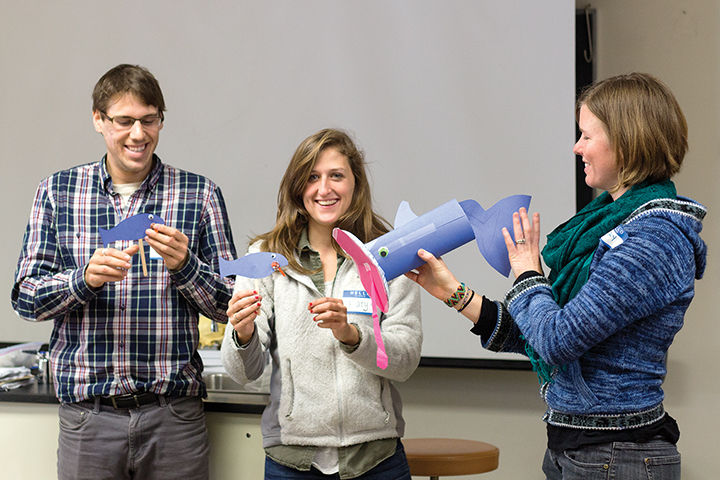
(From left) Adam Spencer, a member of Filmmakers for Conservation, Katy Wellington, second year science education graduate student, and Shalynn Pack, third year conservation biology graduate student, present the fish they designed. Members of the UMD Wildlife Society attend Project Wild in the Animal Science/Agriculture Engineering Building on Sunday, March 8.
Members of this university’s Wildlife Society chapter were taken back to their elementary school days Sunday while participating in a workshop to learn how to better educate others about animals and the environment.
The Wildlife and Heritage Service of this state’s Department of Natural Resources brought the Project WILD workshop to this university. The aim was to train the club members — potential future educators — about wildlife and environmental conservation.
About 20 club members came out to the six-hour workshop in the Animal Science/Agricultural Engineering Building, looking to gain resources and tips on how to educate children and adults about these concepts, said Kerry Wixted, education specialist for the Department of Natural Resources’ Wildlife & Heritage Service and leader of the presentation.
“It’s been very educational and informational. … I’m glad I came here to see how things work out,” freshman biology major Katie Mullen said. “[Working with children in the future] is definitely a possibility.”
Sze Wing Yu, the president of this university’s chapter of the Wildlife Society, said this type of workshop is important for university students among this field to attend so they can use wildlife knowledge to help them in their career plans.
Wixted’s workshop consisted of teaching more than five activities that could be used to instruct different age groups.
For example, one game named “Oh, Deer!” involves one group representing deer, others that act as predators and another that symbolizes natural resources such as water, food and shelter.
In the game, the deer compete for limited resources while the predators hunt the deer, demonstrating the resource competition among species in an ecosystem.
“I didn’t know we were going to do so many activities, [but] I really enjoyed doing it,” said Yu, a senior environmental science and policy major. “We [also] did outdoor activities and people seemed to like it. One was where we split up into groups and went around nearby to look for signs of wildlife and water.”
Another game consisted of students playing the role of grasshoppers looking for food by collecting poker chips. At the end of the activity, Wixted told the students that the white poker chips represented pesticides, as the game was meant to portray bioaccumulation, or the collection of chemicals or pesticides in an organism.
“We all learn about [bioaccumulation] in class, even in high school you’ll learn about it, but it’s more effective when … you count all your chips and you’re like, ‘Oh no, I didn’t survive after all!’ It makes an impact,” Yu said.
Throughout the workshop, Wixted enhanced her explanations with animal replicas and models and facts about wildife in this state. She also handed out fact sheets and children’s books to the students so they could use them if they work with children in the future.
Junior environmental science and policy major Julie Copiz said she found the workshop helpful because it gave her a broader understanding of the concepts she learns in classes.
“[The workshop] gives a better understanding to all ages … so that they appreciate nature more, especially in urban areas where they don’t interact with nature as much,” Copiz said.
Yu said the Wildlife Society might be incorporating these activities for young audiences at their table Maryland Day table later this month.



